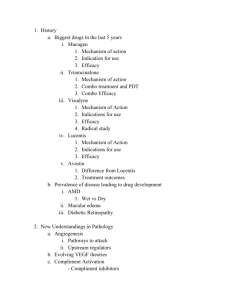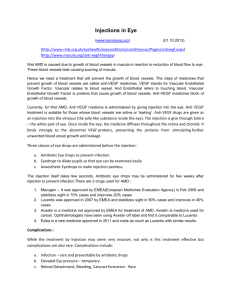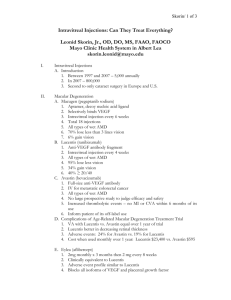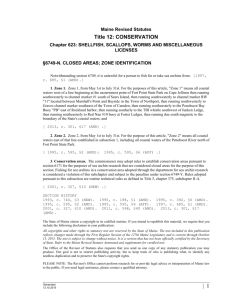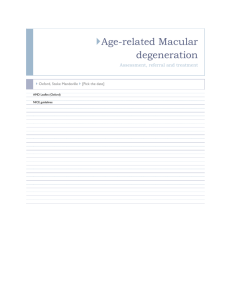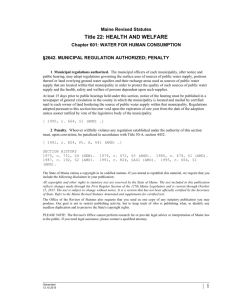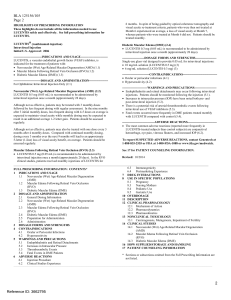Treatment leaflet and Patient - the Royal College of Ophthalmologists
advertisement
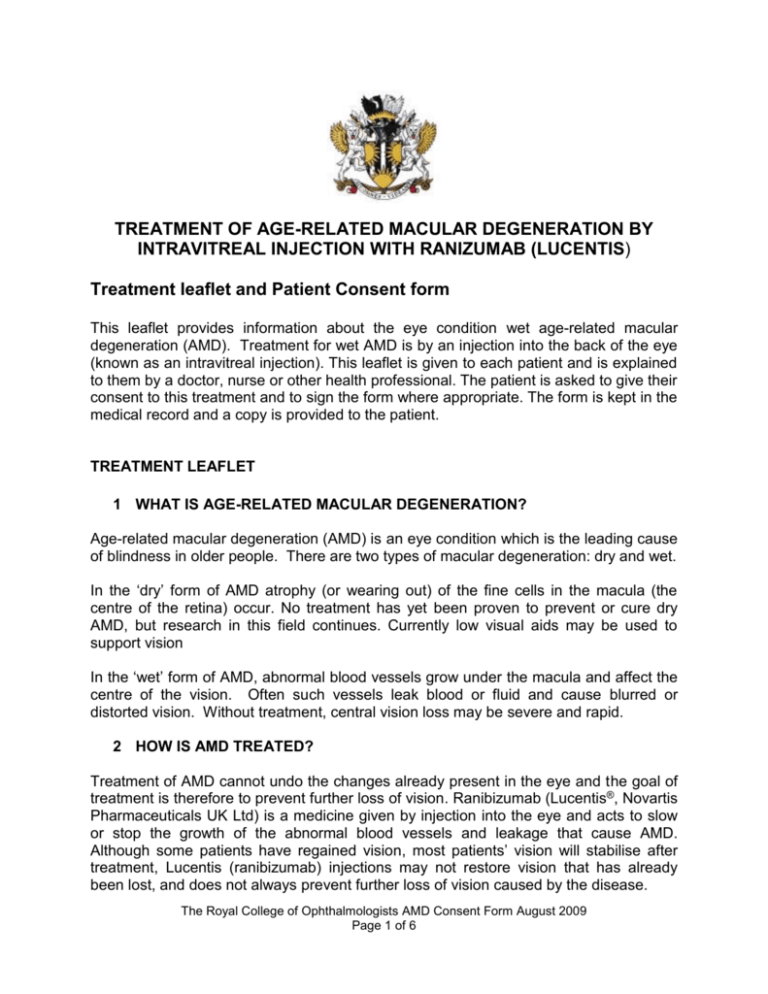
TREATMENT OF AGE-RELATED MACULAR DEGENERATION BY INTRAVITREAL INJECTION WITH RANIZUMAB (LUCENTIS) Treatment leaflet and Patient Consent form This leaflet provides information about the eye condition wet age-related macular degeneration (AMD). Treatment for wet AMD is by an injection into the back of the eye (known as an intravitreal injection). This leaflet is given to each patient and is explained to them by a doctor, nurse or other health professional. The patient is asked to give their consent to this treatment and to sign the form where appropriate. The form is kept in the medical record and a copy is provided to the patient. TREATMENT LEAFLET 1 WHAT IS AGE-RELATED MACULAR DEGENERATION? Age-related macular degeneration (AMD) is an eye condition which is the leading cause of blindness in older people. There are two types of macular degeneration: dry and wet. In the ‘dry’ form of AMD atrophy (or wearing out) of the fine cells in the macula (the centre of the retina) occur. No treatment has yet been proven to prevent or cure dry AMD, but research in this field continues. Currently low visual aids may be used to support vision In the ‘wet’ form of AMD, abnormal blood vessels grow under the macula and affect the centre of the vision. Often such vessels leak blood or fluid and cause blurred or distorted vision. Without treatment, central vision loss may be severe and rapid. 2 HOW IS AMD TREATED? Treatment of AMD cannot undo the changes already present in the eye and the goal of treatment is therefore to prevent further loss of vision. Ranibizumab (Lucentis®, Novartis Pharmaceuticals UK Ltd) is a medicine given by injection into the eye and acts to slow or stop the growth of the abnormal blood vessels and leakage that cause AMD. Although some patients have regained vision, most patients’ vision will stabilise after treatment, Lucentis (ranibizumab) injections may not restore vision that has already been lost, and does not always prevent further loss of vision caused by the disease. The Royal College of Ophthalmologists AMD Consent Form August 2009 Page 1 of 6 3 HOW IS TREATMENT GIVEN? The pupil is dilated and the eye is numbed with anaesthetic drops and washed with iodine. The medication (Lucentis) is injected into the vitreous humour, which is the jellylike substance in the back chamber of the eye. Lucentis (ranibizumab) injections are repeated into your eye once a month for at least three months and later as needed at regular intervals. Your ophthalmologist (eye doctor) will tell you how often you will receive the injection, and over what length of time. It is often necessary to attend for eye examinations and or injections on a monthly basis and perhaps for several years. 4 WHAT OTHER TREATMENT OPTIONS ARE AVAILABLE? Other forms of treatment are available for some types of wet AMD. These include photodynamic therapy (PDT) using a ‘cold laser’ and with a drug called verteporfin (Visudyne®, Novartis Pharmaceuticals UK Ltd) and, in some very limited cases, treatment with conventional or ‘hot’ laser. Some other injections are sometimes used. These options will be explained to you by your eye doctor or nurse. You do not have to receive treatment for your condition. However, if you delay starting treatment, your central vision may continue to get worse over a fairly short time period and to the point where treatment may no longer help. Although AMD hardly ever causes complete blindness, it can reduce the vision to the point where it is only possible to see outlines (known as peripheral vision) or movement but no fine detail because of loss of central vision. 5 WHAT ARE THE RISKS OF TREATMENT? Complications of Lucentis in other body parts There is a theoretical increased risk of experiencing blood clots (such as may cause heart attack or stroke) after intravitreal administration of medicines that affect the growth of blood vessels, such as Lucentis. However, a low incidence of these events was seen in the Lucentis clinical trials. Patients with a history of a stroke may be at greater risk for another stroke. If you have had a stroke, please discuss this with your eye doctor or nurse. Risks of intravitreal eye injections Serious complications of the intravitreal injection procedure include retinal detachment, cataract formation and infection (endophthalmitis) within the eye. Any of these serious complications may lead to severe, permanent loss of vision. In the clinical trials these complications occurred at a rate of less than 0.1% of injections. Other serious events such as inflammation within the eye and increased pressure in the eye occurred at a rate of less than 2% in the clinical trials. More common side effects may include eye pain, conjunctival haemorrhage (bloodshot eye), vitreous floaters, irregularity or swelling The Royal College of Ophthalmologists AMD Consent Form August 2009 Page 2 of 6 of the cornea, inflammation of the eye, and visual disturbances such as small specks in the vision. Infection control You will receive antibiotic eye drops to attempt reduce the possibility of infection occurring following injection. If there are any signs of eye/eyelid infection present on the day of your planned injection, your treatment may need to re-booked for another time to allow control of such infection. Please inform your doctor or nurse if you have a sticky or discharging eye. Coincidental risks Whenever a medication is used in a large number of patients, coincidental problems may occur that could have no relationship to the treatment. For example, patients with high blood pressure or smokers are already at increased risk for heart attacks and strokes. If one of these patients being treated with Lucentis suffers a heart attack or stroke, it may be caused by the high blood pressure and or smoking and not necessarily due to Lucentis treatment The treatment might not be effective for you Your condition may not get better or may become worse despite these injections. Any or all of the complications described above may cause decreased vision and/or have a possibility of causing blindness. Additional procedures may be needed to treat these complications. During follow up visits or phone calls, you will be checked for possible side effects and the results will be discussed with you. Further Information If you would like further information on AMD there are many sources of advice available. Brochures/posters from many relevant patient support groups are available in the ABC Ophthalmic Department. Please ask. The ABC Ophthalmic Department can be contacted directly on telephone number 12345678. Royal National Institute of Blind People. (RNIB) Find out more at www.rnib.org.uk or phone the RNIB Helpline on 0303 123 9999. The Macular Disease Society. Find out more at www.maculardisease.org or phone the Macular Disease Society Helpline on 0845 241 2041. The Royal College of Ophthalmologists AMD Consent Form August 2009 Page 3 of 6 AMD Alliance International provides information on early AMD detection, treatment, rehabilitation and support services, as well as new prevention suggestions. Find out more at www.amdalliance.com The NHS Direct website explains macular degeneration in detail and can be contacted 24 hours a day on 0845 4647 or www.nhsdirect.nhs.uk The Royal College of Ophthalmologists AMD Consent Form August 2009 Page 4 of 6 PATIENT CONSENT FORM 6 Statement of interpreter (where appropriate). I have interpreted the information above to the best of my ability and in a way in which the patient can understand. Interpreter's signature........................................... Print name........................................... Date................. 7 Statement of health professional (only complete if you have appropriate knowledge of this procedure as specified in the ABC trust ‘consent policy’). I have explained the procedure to the patient. In particular in addition to the above I have explained: Signature of Health professional ............................ Job Title............................................. Printed Name………………….............................................................Date.................. 8 Statement of the patient Please read this form carefully. You should already have been offered a copy of this leaflet which describes the risks and benefits of Lucentis injections, but if you don't have one please ask for one now. If you have any further questions, please ask - we are here to help you. You have the right to change your mind at any time, even after you have signed the form. I agree to and request to have the procedure described on this form and which is for a course of such treatment. I understand that: It has not been guaranteed that a particular individual will perform the procedure. The surgeon will, however, have the appropriate experience. Any procedure in addition to those described on this form will only be carried out if it is necessary to save my life, or to prevent serious harm to my health or to my sight. I have been told about additional procedures which may become necessary during my operation. The Royal College of Ophthalmologists AMD Consent Form August 2009 Page 5 of 6 9 PATIENT RESPONSIBILITIES I will contact the ABC Ophthalmic Dept (tele 123456789) if any of the following signs of infection or other complications develop: pain, blurry or decreased vision, sensitivity to light, redness of the eye (compared to immediately after the injection), or discharge from the eye. I have been instructed NOT to rub my eyes or swim for three days after each injection and have been provided with antibiotic eye drops to take. I will keep all postinjection appointments, which may be monthly, or scheduled telephone calls so that staff can check for response to treatment and complications. 10 PATIENT CONSENT The above explanation has been read by/to me. The nature of my eye condition has been explained to me and the proposed treatment has been described. The risks, benefits, alternatives, and limitations of the treatment have been discussed with me. I have been provided with an audio tape/compact disc on this matter by staff at the ABC Ophthalmic Dept. DELETE; if ABC Trust does not provide such. All my questions have been answered. I hereby authorise the eye doctor to administer the intravitreal injection of Lucentis in my ______________________ (state “right” or “left” or ‘both’) eye at regular intervals as needed. ____________________________ Patient’s Signature 11 ___________________ Date Confirmation of consent (To be completed by a health professional when the patient comes in for the procedure, if the patient has signed the form in advance). On behalf of the team treating the patient, I have confirmed with the patient that he or she has no further questions and wishes the procedure to go ahead. Signature of Health Professional.................................................. Name (print)................................... Job Title ......................................................... ........ Date ………………………………. The Royal College of Ophthalmologists AMD Consent Form August 2009 Page 6 of 6
